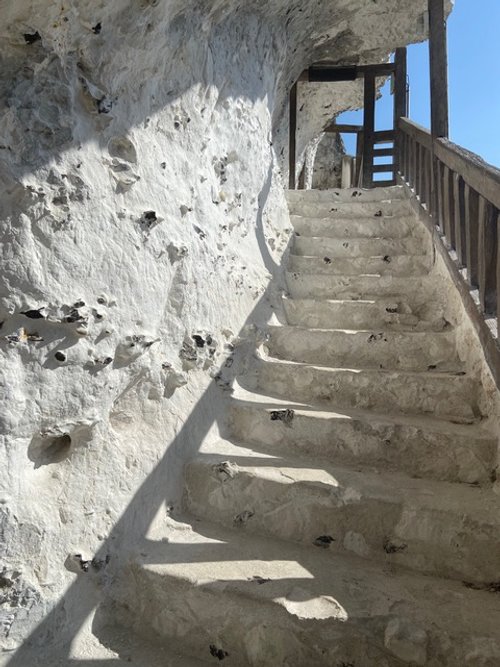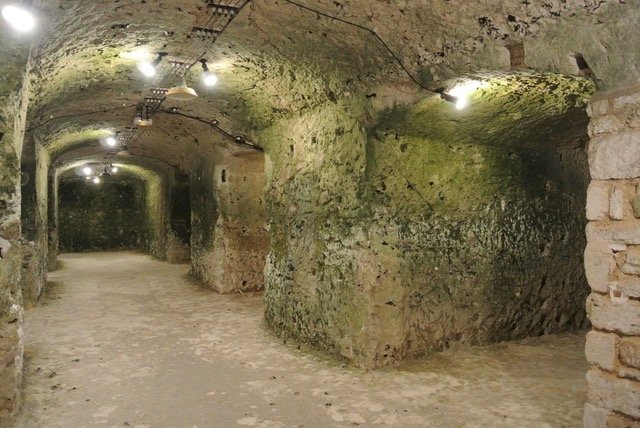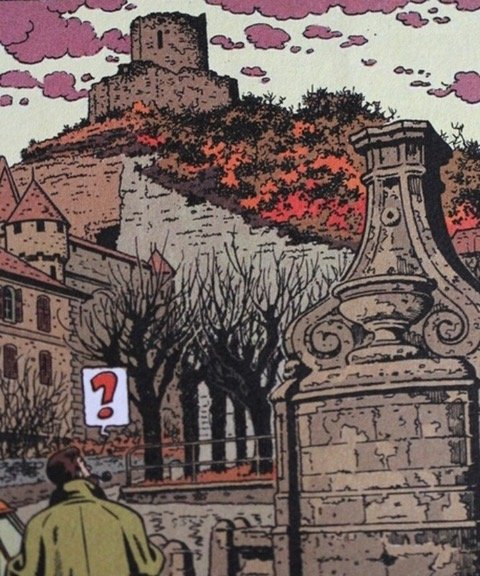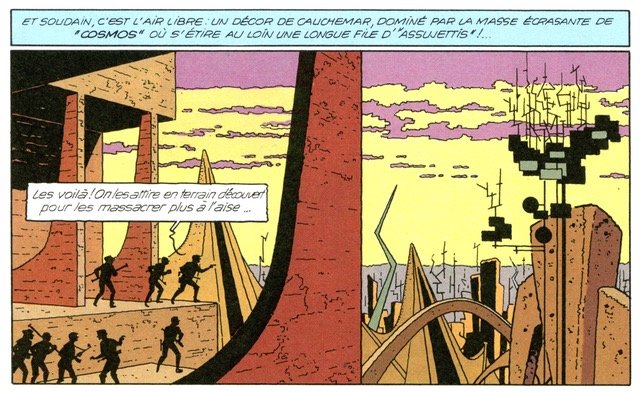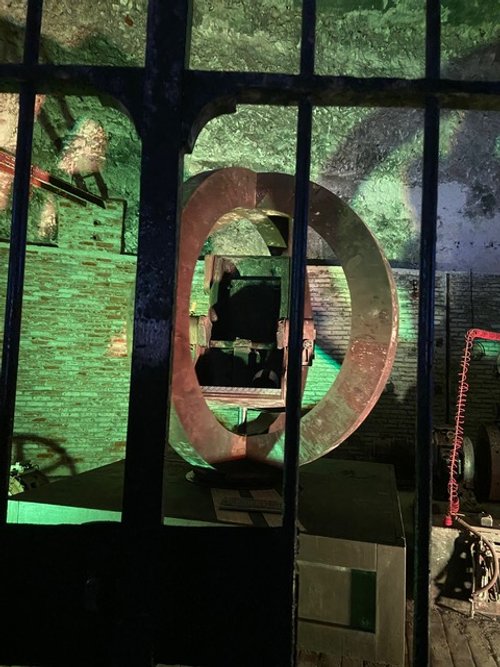Time for Time Traveling
Chateau de La Roche-Guyon and MachinaXion
Field trip! We’re going someplace new. Well, not actually new, parts of its present iteration were constructed in the 3rd century. But new to me, and maybe to you, too. Unless you are one of those people who knows everything there is to know about World War II. As with so many of the things I love about Paris (I don’t think I’ve told you about anything I don’t love - that list is a short one anyhow) this is also a place that stays, if not relevant, then re-visitable because it holds contemporary exhibitions as part of a program called, “On emménage au château:un musée éphémère (We are moving into the castle: an ephemeral museum). Which is exactly why we’re here.
Where? Why the Chateau de La Roche-Guyon. (Figure 1) I was there on a journalist junket - lucky me! (Round trip transportation from Paris, cafe on arrival and lunch before departure, two very knowledgable guides and a goody bag!!!) (Figure 2)
Figure 1. Chateau de La Roche-Guyon
Figure 2. My goodie bag was filled with ….. goodies!
We’ll start with the Chateau and then go to the exhibition. Its history dates to the 3rd century when, according to legend, the widow of the estate’s owner converted to Christianity. She had a sanctuary dug into a cliff to welcome fellow believers.
Some 800 years later, in 1144 to be precise, Abbot Suger visited. I know Suger because he oversaw the rebuilding of Saint-Denis which heralded the birth of Gothic Art. Suger described the site this way: "On a promontory formed in a place difficult to access by the banks of the great river of the Seine, is built a not noble castle, of a frightening aspect … invisible on its surface, dug into a high rock (accessed by) a narrow opening, form(ing a) vast underground dwelling.” Creepy right? Wait til you see it !
Not long after Suger’s visit, King Philippe II Auguste visited the chateau. To ensure the loyalty of its owner, the King granted him the right to collect tolls for boats sailing on the Seine. For which the owner, Guy de La Roche had to keep the river navigable. To protect the site from the King’s enemies, Guy built a chateau with a circular donjon 35 meters high, overlooking the Seine. (Figure 3) With a staircase dug into the cliff to connect it to the troglodyte (underground) chateau. I didn’t count but I walked up and down lots of massive stone stairs carved into the cliff - going from the chateau to the pigeonnier (Figure 4) to the donjon. If you do climb them all, you will be rewarded with a heart attack or magnificent views of the Seine. Maybe both.
Figure 3. View of the Seine from the Chateau
Figure 4. Steps from Chateau to pigeonnier
Things were dicey for this family during the Hundred Years War, when the then Guy (#6) was killed in Agincourt in 1415. As towns and villages and chateaux fell to the English, this chateau remained impregnable. But after a 6 months siege, Henry V of England came to see Guy #6 la Roche’s widow. Her choice: swear allegiance to England or leave the chateau. She left, with her children, without her stuff. The English were finally expelled from France in 1449. The family regained possession.
By the 17th century, the chateau’s defensive functions were mostly a thing of the past and it became an elegant residence that welcomed guests like François I and Henri IV. In the 18th century, major works were undertaken at the chateau by Duke Alexandre de La Rochefoucauld who was very close to Louis XV until he started bad mouthing the king’s mistress. Banished from court, he spent the rest of his life studying geography and philosophy and fixing up his chateau.
When he died, his daughter, the Duchess of Enville, inherited the chateau. (Figure 5) And both there and at her home in Paris, the Duchess hosted a salon where philosophers, scholars and political thinkers met. She was politically liberal and exchanged books with Rousseau and Turgot. All the while continuing to furnish her chateau and work on her garden, (now restored) where she introduced clover, alfalfa, and potatoes as well as exotic trees. (Figure 6) Everything was going fine until the French Revolution. In 1792, she saw her son Louis-Alexandre killed by a stone hurled at him by a sans-culotte. Then she and her daughter-in-law were arrested and imprisoned for two years. During the Terror, the donjon was ordered destroyed. But destruction was only half hearted since the locals liked the duchess. The stones that were taken can now be found throughout the village, used to construct more modest abodes.
Figure 5. Duchesse d'Enville
Figure 6. Potager of Chateau de La Roche-Guyon
Let’s see, what else. Victor Hugo visited twice, in 1821 and again in 1835. Here is what he wrote, in part, to his daughter Adèle during the second trip, "I am at La Roche-Guyon… Fourteen years ago, almost to the day, I was here…Nothing is changed in this sad and severe landscape. Always this beautiful crescent of the Seine, always this dark rim of hills, always this vast blanket of trees. Nothing is changed either in the castle, except the master who is dead, and me, the passer-by, who is old….
Who else? On, right, in 1944, General Field Marshal Rommel, charged with defending the French coasts against an Allied landing, chose this chateau as his headquarters. (Figures 7, 8) When he knew the gig was up, that the Nazis were facing inevitable defeat, he met secretly with the commander-in-chief of the German army in France to figure out how to overthrow the Nazi regime and end the war. “Almost every day personalities from the Reich arrived to express themselves freely in the oasis of Rommel's headquarters, far from the clutches of the Gestapo”. In June, Rommel asked Hitler to join him at La Roche-Guyon where he intended to have him arrested. But Hitler foiled his plan and went back to Germany. On July 17, returning from an inspection of Normandy, Rommel’s car was strafed by Allied planes. His driver was killed and he was injured. Following a failed attack against Hitler, Rommel was accused of high treason and ordered to commit suicide. He did. Even though he and the German army had decamped, the Allies bombed the Chateau, causing enormous damage.
Figure 7. Rommel in front of Chateau de La Roche-Guyon
Figure 8. Rommel’s shelter underneath Chateau de La Roche-Guyon
So, why was I at this chateau? For an exhibition, of course. But before I tell you about that, I want to tell you about two things I saw as I wandered around. This chateau, like so many others, is mostly empty. Some of the heirloom pieces were sold by the families that owned them, others were stolen at one time or another, mostly during the French Revolution.
Two special things are here, though. One is in a tiny space covered in lovely, delicate Chinoiserie wallpaper. I learned that it dates from the 18th century and was made in China. The panels depict the picking, drying and trading of tea. (Figures 9, 10) Two westerners are in the final scene. One is talking to a Chinese official, the other is already on the boat. They are probably the Dutch traders in whose boat the tea will make its way to Europe.
Figure 9. Chinoiserie wallpaper Chateau de La Roche-Guyon
Figure 10. Chinoiserie wallpaper, detail, Chateau de La Roche-Guyon
In another room I saw a set of Gobelins tapestries, based on paintings by the French artist, Jean-Francois de Troy. So, obviously, they deserved a closer look. And much to my surprise, they were scenes from the life of the Old Testament heroine, Esther. You know Esther. Of Purim fame? The tapestries were commissioned (like the chinoiserie wallpaper) by the Duchess of Enville, that enlightened aristocrat with liberal leanings. One historian has suggested that the tapestries were a plea for religious tolerance. Not for the Jews of course, but for the Protestants in Catholic France. The tapestries recount the key events from the Book of Esther. The Persian King Ahasuerus chooses Esther as his bride. Mordecai, Esther's uncle, asks her to intercede with the king on behalf of her people who are being threatened with massacre by the Grand Vizier Haman. Esther agrees even though she knows that asking for an audience with the king is punishable by death. But Ahasuerus is not angry. His young bride is beautiful. Although he is surprised to learn that she is Jewish. Esther begs Ahasuerus to spare her people. Ahasuerus hangs Haman instead. (Figures 11, 12, 13)
Figure 11. La Toilette d’Esther (preparing to see King Ahsuerus)
Figure 12. King Ahasuerus and Queen Esther
Figure 13. Mordecai and Haman
Now, let’s talk about the exhibition I was invited on this press junket to see, called MachinaXion based upon a bande dessinée (comic book) whose action takes place in this Chateau. The cartoon, Le Piège diabolique (The Time Trap) (Figure 14) was written and illustrated by the Belgium cartoonist Edgar Jacobs who was born in Brussels in 1904. Although his real ambition had been to be an opera singer, when that didn’t pan out he went back to something he had done all his life - draw. But an opera he had seen when he was 13 years old, stayed with him throughout his life. The opera was Faust and the idea of making a pact with the Devil to gain universal knowledge was never far from his thoughts. In this exhibition, the opera is the soundtrack.
Figure 14. Cover of Le Piège Diabolique
Jacobs began drawing for Hergé, originator of Tintin. And it was in the Tintin magazines that Jacobs introduced his own characters, Philip Mortimer, a British scientist and Captain Francis Blake, from MI5. Their adventures are a mix of science fiction (Mortimer’s department) and criminal investigations (Blake’s area of expertise).
According to Jacobs’ biographers, his genius lay in expertly using the limited palette available to cartoon illustrations. "Right from the start," according to Benoît Mouchart and François Rivière, "Jacobs understood just what a story had to gain from the interplay of colors… He was the first artist in Belgium to realize just what dramatic effects could come out of color.”
In addition to color, Jacobs used a lot of text, which seems redundant if you actually look at the images he draws. (Figure 15) But according to his biographers, Jacobs was a person who ‘prized laboriousness… He spent months on research and produced numerous iterations of every element and every page.” Obsessed as he was with visual storytelling, he left nothing to chance - composition, proportion and rhythm all played their part in the tales he told.
Figure 15. Page of book showing subtle range of colors & lots of text
Le Piège diabolique (The Time Trap) revolves around the scientist Mortimer's solo unplanned trip through time. Piège combines two of Jacobs’ favorite themes - prehistoric terror and nuclear catastrophe. Which in this tale are combined with a third theme - medieval mayhem. And that’s the part that takes place at La Roche-Guyon.
When Jacobs saw the chateau in 1958, he knew it was perfect. He took photographs of the chateau and village, then returned to his studio in Belgium and got to work. Le Piège diabolic was published in Belgium in 1962. Its publication in France was delayed for 5 years, it was deemed too violent by the French censors.
Here’s the set-up. Mortimer’s old adversary, Dr. Miloch, has bequeathed the duo a scientific discovery hidden inside a house in La Roche-Guyon. Since Blake was busy, Mortimer is on his own. He finds the house and the ‘chronoscaphe’ (time machine) that Miloch made for him. He gets inside the machine, activates it and immediately loses consciousness. When he comes to, he is in a prehistoric swamp of 150 million years ago. He escapes but doesn’t get any farther than the Middle Ages, inside Chateau de La Roche Guyon. (Figure 16) Just in time for a peasant revolt (the revolt that took place here during the 100 Years War). Mortimer witnesses the rebels storming the castle. He challenges their leader, Jacques Bonhomme, (a real historical figure connected to the uprising) to unarmed single combat. Of course Mortimer wins, Bonhomme doesn’t know judo. The next time Mortimer stops the ‘chronoscaphe', he is in the ruined remains of a modern underground city destroyed in an apocalyptic war. He learns that the year is 5060 (Figure 17) and that the Earth had been devastated by a nuclear war three thousand years earlier.
Figure 16. Coming upon the Chateau de La Roche-Guyon
Figure 17. The future, Le Piège Diabolique
Mortimer eventually gets back into the present but the ‘chronoscaphe’ and laboratory are destroyed. (Figure 18)The duo decide that it is best to keep the details of Mortimer’s adventure confidential. Although Mortimer does remark that in the future, the 20th century might very well be considered “the good old times” .
Figure 18. Recreation of the ‘chronoscaphe’
I met an American woman when I was at the Chateau completely by chance. She was on a Seine cruise. That day they stopped at both Chateau de La Roche-Guyon and Giverny. I looked on a map. They are very close. You can easily get to Giverny from Paris. A taxi from Giverny to La Roche Guyon takes 12 minutes. To return, all you would need to do is take a taxi to the train station in Vernon which is where you arrive on your way to Giverny. A quick and easy trip back to Paris. Sounds like an excellent adventure. In both time and space travel. (Figure 19, 20)
Figure 19. In the pigeonnier at Chateau de La Roche-Guyon
Figure 20. The scene that greeted Mortimer when he arrived at de La Roche-Guyon, and me, too




